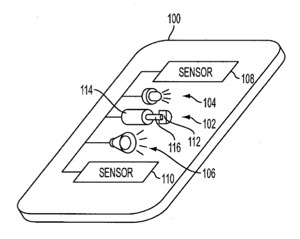An Apple patent (number 20110077055) for a self-adapting alert device has appeared at the US Patent & Trademark Office. In other words, Apple is working to make sure that you don’t miss an iPhone call even in a noisy environment.
Methods and apparatuses are disclosed that allow an electronic device to autonomously adapt one or more user alerts to the current operating environment of the electronic device. For example, some embodiments may include a method comprising providing a plurality of alert devices in an electronic device, determining an operating environment of the electronic device using a sensor of the electronic device, and actuating at least one of the plurality of alert devices that corresponds to the determined operating environment. The inventors are Dave Pakula, Matthew Hill, Ethan Larry Huwe, Fletcher Rothkopf and Richard Hung Minh Dinh.
Here’s Apple’s background and summary of the invention: “Electronic devices are ubiquitous in society and can be found in everything from wristwatches to computers. Many of these electronic devices are portable and also include the ability to obtain a user’s attention through the use of an alert device. For example portable electronic devices like cellular phones and watches contain alert devices such as vibrating motors, speakers, and/or lights to attract the user’s attention.
“Because of their portable nature, many of these portable electronic devices are made as small as possible by miniaturizing the components therein. As part of this miniaturization effort, the alert devices in the electronic devices are often made as small as possible in order to conserve space. However, these miniaturized alert devices can be problematic for several reasons.
“First, these miniaturized alert devices may be inadequate to obtain the user’s attention in a variety of different situations. For example, if the user of a cell phone is in an environment where there is a great deal of ambient noise, such as a concert or live sporting event, then the user may be unable to see a visual alert from a miniaturized light on the phone, hear an auditory alert from a miniaturized speaker in the phone and/or unable to detect vibration coming from the phone’s miniaturized vibration motor.
“Additionally, because of electronic devices often contain slight variations in the way they were manufactured, the actual response of the alert device within the electronic device may vary between electronic devices. In other words, slight variations in the actual manufacturing of an electronic device may cause the electronic device to react differently to the same force driving the alert device. For example, the vibration frequency may vary between phones of the same make and model because of manufacturing tolerance, and therefore, the same amount of vibration from a vibrating motor may unintentionally produce different levels of user alerts.
“Thus, methods and systems that adaptively adjust the alert devices within electronic devices to overcome one or more of these problems are desirable.
“Methods and apparatuses are disclosed that allow an electronic device to autonomously adapt one or more user alerts to the current operating environment of the electronic device. For example, some embodiments may include a method comprising providing a plurality of alert devices in an electronic device, determining an operating environment of the electronic device using a sensor of the electronic device, and actuating at least one of the plurality of alert devices that corresponds to the determined operating environment.
“Other embodiments may include an electronic device that autonomously adjusts a user alert, the electronic device comprising a storage unit, an error detector couple to the storage unit, a sensor coupled to the error detector, a motor controller coupled to the error detector, and a motor coupled to the motor controller, wherein a reference value stored in the storage unit is varied to achieve a target frequency of the electronic device.
“Still other embodiments may include a method of adjusting user alerts in an electronic device, the method comprising determining a current operating environment from a sensor of the electronic device, storing an initial reference value corresponding to an initial target frequency of the electronic device in the current operating environment, and in the event that the user alert is to be optimized, then the method further comprises modifying the initial reference value and storing measurements from the sensor.”
— Dennis Sellers




